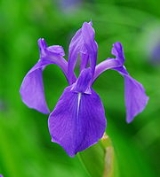
Kakitsubata
Encyclopedia
Iris laevigata, Rabbit-Ear Iris or kakitsubata, is a Japanese species of iris
related to other members of Iris subgenus Limniris, including other species of Japanese iris
es. It is found growing in shallow waters and seems to prefer marshy and still ponds although it can also be grown in damp soil if conditions are right. Flowers are usually blue, purple or violet and have unique colour patterns including some types with predominantly white flowers with blue spots, called Washino-o and dark purples bordered with white, called Maikujaku.
Alternative names for Iris laeviegata are Iris albopurpurea and Iris phragmitetorum. It is sometimes known commonly as Shallow-flowered Iris or yan zi hua.
The Kakitsubata, or Iris laeviegata, has been cultivated in Japan for more than a thousand years and some varieties mentioned in Japanese gardening books in the late 17th century are still in existence.
) one can find a lovely example of a water garden in the Yatsuhashi Kakitsubata Garden (八橋かきつばた園) at the Muryojuji Temple which has been known for its Kakitsubata garden since the Heian period
and is also the place where the Japanese Poet Ariwara no Narihira
wrote a poem in the Ise Monogatari using the five initial letters of Ka-Ki-Tsu-Ba-Ta. The poem goes:
Iris (plant)
Iris is a genus of 260-300species of flowering plants with showy flowers. It takes its name from the Greek word for a rainbow, referring to the wide variety of flower colors found among the many species...
related to other members of Iris subgenus Limniris, including other species of Japanese iris
Japanese iris
The term "Japanese iris" encompasses three varieties of Irises cultivated in gardens or growing wild in Japan: hanashōbu, kakitsubata and ayame....
es. It is found growing in shallow waters and seems to prefer marshy and still ponds although it can also be grown in damp soil if conditions are right. Flowers are usually blue, purple or violet and have unique colour patterns including some types with predominantly white flowers with blue spots, called Washino-o and dark purples bordered with white, called Maikujaku.
Alternative names for Iris laeviegata are Iris albopurpurea and Iris phragmitetorum. It is sometimes known commonly as Shallow-flowered Iris or yan zi hua.
Cultivation
The kakitsubata differs from the Japanese Iris mainly in being more dependent on water and in lacking the strong midrib of the foliage. When grown from seeds, they usually germinate in 30–545 days although even under good conditions germination may be erratic. Seeds should be sown about 6 mm deep in a peaty seed sowing mix at about 15-20°C with frequent watering. Some varieties are almost ever-blooming even in mild climates, which makes it a good candidate for water gardens in temperate areas in Europe and the Americas.The Kakitsubata, or Iris laeviegata, has been cultivated in Japan for more than a thousand years and some varieties mentioned in Japanese gardening books in the late 17th century are still in existence.
History and Culture
In (Aichi prefecture , JapanJapan
Japan is an island nation in East Asia. Located in the Pacific Ocean, it lies to the east of the Sea of Japan, China, North Korea, South Korea and Russia, stretching from the Sea of Okhotsk in the north to the East China Sea and Taiwan in the south...
) one can find a lovely example of a water garden in the Yatsuhashi Kakitsubata Garden (八橋かきつばた園) at the Muryojuji Temple which has been known for its Kakitsubata garden since the Heian period
Heian period
The is the last division of classical Japanese history, running from 794 to 1185. The period is named after the capital city of Heian-kyō, or modern Kyōto. It is the period in Japanese history when Buddhism, Taoism and other Chinese influences were at their height...
and is also the place where the Japanese Poet Ariwara no Narihira
Ariwara no Narihira
was a Japanese waka poet and aristocrat. He was one of six waka poets referred in the preface in kana to Kokin Wakashū by Ki no Tsurayuki, and has been named as the hero of The Tales of Ise, whose hero was an anonym in itself but most of whose love affairs could be attributed to Narihira.He was the...
wrote a poem in the Ise Monogatari using the five initial letters of Ka-Ki-Tsu-Ba-Ta. The poem goes:
The Kikatsubata is the prefectural flower of Aichi prefecture as well as of Chiryū City. Each year at the end of April a festival is held in the temple garden as a celebration of the flowering and attracts about 250,000 visitors each year.
KArakoromo KItsutsu narenishi TSUma shi areba HArubaru kinuru TAbi wo shi zo omou (HA can also be read BA).

